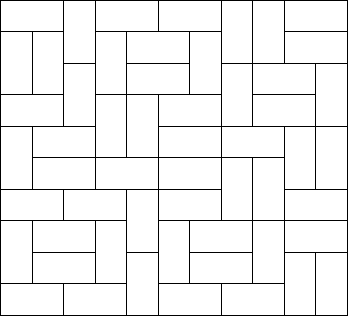Mondriaan's Dream
| Time Limit: 3000MS | Memory Limit: 65536K | |
| Total Submissions: 9975 | Accepted: 5772 |
Description
Squares and rectangles fascinated the famous Dutch painter Piet Mondriaan. One night, after producing the drawings in his 'toilet series' (where he had to use his toilet paper to draw on, for all of his paper was filled with squares and rectangles), he dreamt
of filling a large rectangle with small rectangles of width 2 and height 1 in varying ways.

Expert as he was in this material, he saw at a glance that he'll need a computer to calculate the number of ways to fill the large rectangle whose dimensions were integer values, as well. Help him, so that his dream won't turn into a nightmare!
of filling a large rectangle with small rectangles of width 2 and height 1 in varying ways.

Expert as he was in this material, he saw at a glance that he'll need a computer to calculate the number of ways to fill the large rectangle whose dimensions were integer values, as well. Help him, so that his dream won't turn into a nightmare!
Input
The input contains several test cases. Each test case is made up of two integer numbers: the height h and the width w of the large rectangle. Input is terminated by h=w=0. Otherwise, 1<=h,w<=11.
Output
 For each test case, output the number of different ways the given rectangle can be filled with small rectangles of size 2 times 1. Assume the given large rectangle is oriented, i.e. count symmetrical
For each test case, output the number of different ways the given rectangle can be filled with small rectangles of size 2 times 1. Assume the given large rectangle is oriented, i.e. count symmetricaltilings multiple times.
Sample Input
1 2 1 3 1 4 2 2 2 3 2 4 2 11 4 11 0 0
Sample Output
1 0 1 2 3 5 144 51205
Source
状态压缩DP
状态:第i行向第i+1行凸出的地方。即如果有向第i+1行的凸出,就记录为1,否则记录0。
#include<cstdio>
#include<cstring>
#include<algorithm>
using namespace std;
__int64 N,M,cur;
__int64 d[2][1<<11];
__int64 num[1<<11];
void DFS(__int64 x,__int64 pos,__int64 flag)
{
if(pos==M)
{
if(!flag)
num[++num[0]]=x;
return ;
}
DFS(x,pos+1,flag^1);
if(flag==0)
DFS(x|1<<pos,pos+1,flag);
}
int main()
{
__int64 i,j,k,tmp;
while(scanf("%I64d%I64d",&N,&M),N||M)
{
if(N<M) swap(N,M);
if(M==1)
{
if(N%2)
printf("0\n");
else
printf("1\n");
continue;
}
if(M%2 && N%2)
{
printf("0\n");
continue;
}
num[0]=0;
DFS(0,1,1); DFS(1,1,0);
cur=0; memset(d[cur],0,sizeof(d[cur]));
d[cur][0]=1;
for(i=0;i<N;i++)
{
cur^=1; memset(d[cur],0,sizeof(d[cur]));
for(j=1;j<=num[0];j++)
{
for(k=0;k<(1<<M);k++)
{
if((num[j]&k)!=k)
continue;
d[cur][num[j]^k]+=d[cur^1][k];
}
}
}
printf("%I64d\n",d[cur][0]);
}
return 0;
}
轮廓线状态压缩DP:
#include<cstdio>
#include<cstring>
using namespace std;
__int64 H,W,cur;
__int64 d[2][1<<11];
void updata(__int64 a,__int64 b)
{
if(a&(1<<W))
{
d[cur][a^(1<<W)]+=d[cur^1][b];
}
}
int main()
{
__int64 i,j,k,tmp,Max;
while(scanf("%I64d%I64d",&H,&W),H||W)
{
if(H<W)
{
tmp=H; H=W; W=tmp;
}
cur=0; memset(d[cur],0,sizeof(d[cur]));
d[cur][(1<<W)-1]=1;
for(i=1;i<=H;i++)
for(j=1;j<=W;j++)
{
cur^=1; memset(d[cur],0,sizeof(d[cur]));
for(k=0;k<(1<<W);k++)
{
updata(k<<1,k);
if(i>1 && !(k&(1<<(W-1))) )
updata( (k<<1)|1|(1<<W) ,k);
if(j>1 && !(k&1))
updata( (k<<1)|3,k );
}
}
printf("%I64d\n",d[cur][(1<<W)-1]);
}
return 0;
}